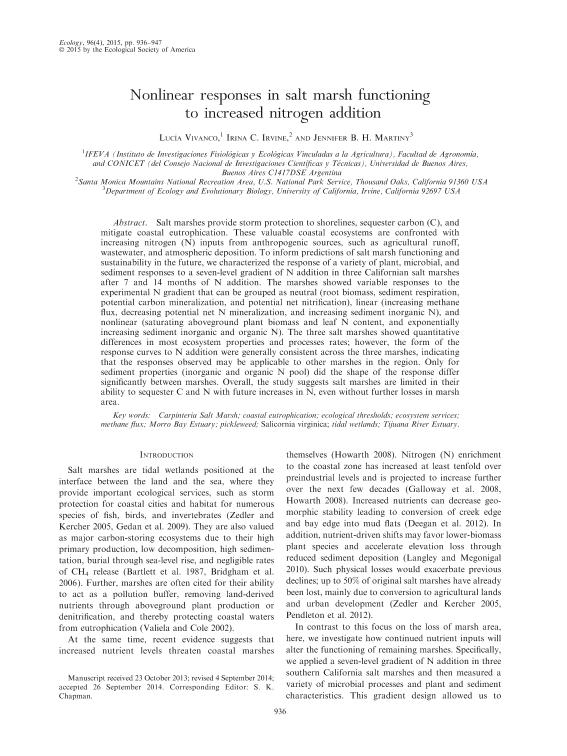Mostrar el registro sencillo del ítem
dc.contributor.author
Vivanco, Lucía

dc.contributor.author
Irvine, Irina C.

dc.contributor.author
Martiny, Jennifer B. H.

dc.date.available
2017-06-05T14:47:33Z
dc.date.issued
2015-04
dc.identifier.citation
Vivanco, Lucía; Irvine, Irina C.; Martiny, Jennifer B. H.; Nonlinear responses in salt marsh functioning to increased nitrogen addition; Ecological Society Of America; Ecology; 96; 4; 4-2015; 936-947
dc.identifier.issn
0012-9658
dc.identifier.uri
http://hdl.handle.net/11336/17470
dc.description.abstract
Salt marshes provide storm protection to shorelines, sequester carbon (C), and mitigate coastal eutrophication. These valuable coastal ecosystems are confronted with increasing nitrogen (N) inputs from anthropogenic sources, such as agricultural runoff, wastewater, and atmospheric deposition. To inform predictions of salt marsh functioning and sustainability in the future, we characterized the response of a variety of plant, microbial, and sediment responses to a seven-level gradient of N addition in three Californian salt marshes after 7 and 14 months of N addition. The marshes showed variable responses to the experimental N gradient that can be grouped as neutral (root biomass, sediment respiration, potential carbon mineralization, and potential net nitrification), linear (increasing methane flux, decreasing potential net N mineralization, and increasing sediment inorganic N), and nonlinear (saturating aboveground plant biomass and leaf N content, and exponentially increasing sediment inorganic and organic N). The three salt marshes showed quantitative differences in most ecosystem properties and processes rates; however, the form of the response curves to N addition were generally consistent across the three marshes, indicating that the responses observed may be applicable to other marshes in the region. Only for sediment properties (inorganic and organic N pool) did the shape of the response differ significantly between marshes. Overall, the study suggests salt marshes are limited in their ability to sequester C and N with future increases in N, even without further losses in marsh area.
dc.format
application/pdf
dc.language.iso
eng
dc.publisher
Ecological Society Of America

dc.rights
info:eu-repo/semantics/openAccess
dc.rights.uri
https://creativecommons.org/licenses/by-nc-sa/2.5/ar/
dc.subject
Ecological Thresholds
dc.subject
Ecosystem Services
dc.subject
Coastal Eutrophication
dc.subject
Tidal Wetlands
dc.subject.classification
Ecología

dc.subject.classification
Ciencias Biológicas

dc.subject.classification
CIENCIAS NATURALES Y EXACTAS

dc.title
Nonlinear responses in salt marsh functioning to increased nitrogen addition
dc.type
info:eu-repo/semantics/article
dc.type
info:ar-repo/semantics/artículo
dc.type
info:eu-repo/semantics/publishedVersion
dc.date.updated
2017-06-02T17:32:33Z
dc.journal.volume
96
dc.journal.number
4
dc.journal.pagination
936-947
dc.journal.pais
Estados Unidos

dc.description.fil
Fil: Vivanco, Lucía. Consejo Nacional de Investigaciones Científicas y Técnicas. Oficina de Coordinación Administrativa Parque Centenario. Instituto de Investigaciones Fisiológicas y Ecológicas Vinculadas a la Agricultura. Universidad de Buenos Aires. Facultad de Agronomía. Instituto de Investigaciones Fisiológicas y Ecológicas Vinculadas a la Agricultura; Argentina
dc.description.fil
Fil: Irvine, Irina C.. National Park Service; Estados Unidos
dc.description.fil
Fil: Martiny, Jennifer B. H.. University of California at Irvine; Estados Unidos
dc.journal.title
Ecology

dc.relation.alternativeid
info:eu-repo/semantics/altIdentifier/doi/http://dx.doi.org/10.1890/13-1983.1
dc.relation.alternativeid
info:eu-repo/semantics/altIdentifier/url/http://onlinelibrary.wiley.com/doi/10.1890/13-1983.1/abstract
Archivos asociados
